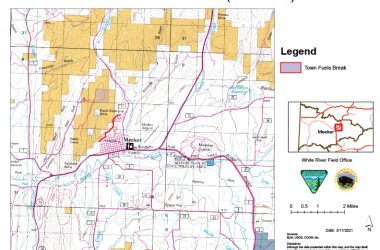Editor’s note: Following the announcement of the temporary closing of the gym at the new Meeker Elementary School, Mary Strang, president of the Meeker School Board, responded to a set of questions about the new school:
1. How many other sites were considered and where were they located?
Three sites were considered:
• On the hill above and north of Starbuck Stadium
• The present site — actually the present site is a compromise of sorts as the building was moved up the hill some from the original site along Sulphur Creek
• Sanderson Hills
As you will recall we held multiple community meetings on the site selection and solicited input from the staff, parents and the community at large. There were definitely pros and cons for each site.
2. What were the reasons for selecting this particular site?
In our opinion, the present site best met the criteria of campus setting, safe and easy access and expandability for growth. Both site A and site B required a bridge across Sulphur Creek and a road from it to the school. This additional route was necessary from the perspective of emergency preparedness. Otherwise, all three school buildings (elementary, middle and high schools) could be held hostage.
Site A had some definite advantages, which included closer proximity to the middle school, a much easier sewer design and, like B, it would create a campus setting with the other two buildings. The drawbacks included its exposure to weather, the expense of building a road from Sulphur Creek up to the top of the hill and the parking area would have been more restricted and taken in the Rich Lyttle Memorial discus throwing field — something which we would have had to relocate. Also, the parking facilities could only be used for school events as its location didn’t allow a community component, such as we have at our present site. It would have been a hazard to have elementary students coming off the hill on bicycles against oncoming uphill traffic after school, as well. The primary access would have to be from the Sulphur Creek side because we couldn’t add any more traffic past the high school. Nobody wanted elementary students mixed with the high school traffic. Given this reality, the road up the hill from Sulphur Creek would have to be a primary access road — not a secondary one.
Site C would have been very handy for residential property owners in the area, but the site wasn’t large enough to offer room for growth and adequate parking. Also, it couldn’t provide a campus setting. Campus setting was an important criteria because if facilitates all three buildings sharing special staff people and the facilities can be used by the other two schools.
Site B seemed like the best compromise. Its proximity to the rec center is another plus as many kids walk there after school for after-school programs and the rec district can use our facilities easily as well. In fact, there are innumerable ways we can reciprocate with the rec department because of our proximity to the rec center.
3. Were soil tests conducted on the site that was chosen and, if so, what were the results?
Extensive soil tests were run by two engineering firms specializing in this field. They found that the soils at the school site included:
• Sandy lean clay with clay stone fragments
• Silty sand with varying amounts of gravel
• Clayey sand with varying amounts of gravel (Out of six bored holes, this sort of soil was only found in one hole. It lay beneath the sandy lean clay and the silty sand with varying bits of gravel.)
• Last was shale, which would expand if it got wet.
In short, from top to bottom: sandy soils, then wet clay and finally the bedrock, which is expansive shale. The main difference in removing water from sand and clay is that with sand it’s like squeezing water out like a sponge. With this kind of clay, it’s like squeezing water out of a plastic bag with small holes. Once the water is out and the clay has consolidated, it will not spring back, but will stay consolidated. The shale is much closer to the surface on the east side of the building — it slopes downward significantly as you go from east to west on the site. It was critical that a system be designed to keep all water away from the shale. If it got wet and expanded, then the building would move. The good news about the issue with the gymnasium east wall is that after excavating there was no water. Our system is successful.
Two layers of engineering (two different firms) were used to come up with the best solution for a foundation system described under question 5. A third engineering firm was hired to review the design of these two firms in an effort to exercise due diligence in resolving a complicated problem.
4. Were caissons recommended for the new building?
Yes. Three different systems using different kinds of caissons were explored by two sets of engineers in January of 2009. I’ll call them options A, B and C.
The more these were reviewed, the more unpredictable any kind of caisson system seemed to be. For instance, possibly, if water traveled down one caisson to the bedrock underneath it, the rock would expand as it got wet. The net effect could be that one caisson would be pushed up while others were not. Costs became more unpredictable as the options were discussed with engineers and contractors. Estimated costs could double if piles took longer to drill depending on the cobble/boulders encountered. Estimated time to construct could greatly increase and delay the whole project. If successful, compared to Option D, there was no real advantage in terms of the movement of the building — a difference of half inch at most — from a half inch to one inch.
5. Explain the additional excavation work that was done to compensate for the soil issue.
Option D was presented and included a spread footing with a five-inch slab on grade. Over excavate the site 10 feet, and pack the fill. This was the best solution and the most economical. The process used was as follows:
Over excavate the site by 10 feet and fill with acceptable material and pack fill.
The over excavation went 10 feet deep and 5 five out from the edge of building.
Much of the over-excavated material was acceptable to use, so they didn’t have to haul in all new fill.
Material was sorted as site was over excavated — shale material wasn’t used.
Least chance of any differentiated movement.
If there is any problem with this foundation option it will be a lot easier to fix.
Sequence of materials in the foundation:
• Five-inch slab
• Grade beam under slab on perimeter of building with four-inch void forms under the grade beam. The void forms eventually disintegrate and a void remains.
• Ten-foot fill
• Foundation was point loaded on columns every three feet, with a pad under each column on perimeter and under whole slab.
• Design included multiple ways to avoid water getting to shale under foundation and other ways of preventing heaving of building.
Exterior of building
• Slope away at 10 percent from building for 10 feet
• Clay cap with EPDM under clay cps
• No roof drains next to building
• Wall control joints (expansion joints) for stucco and masonry walls
Interior
• Slab control joints
• Wall control joints
• Interior to exterior wall slip connection
• Ceiling slip connection
• Slip tracks at top of wall
Option D was approved contingent upon a third-party opinion on engineering of foundation system using Terracon’s soil analysis information.
We did over excavate and then put a 10-foot overburden of dirt on top of the back fill of over excavation. This was to stabilize the wet clay — which once stabilized does not spring back. The settling with the overburden was monitored very carefully and once the wet clay was deemed compact (it took about two weeks — which was standard, according to the soils engineers) the overburden was removed. At this point, the soils engineers were confident we had no worries.
6. Who did the inspection on the new school?
As far as the inspections go, the state of Colorado has jurisdiction over all construction at public schools. Plans have to be approved, permits given and final inspections are all the responsibility of the state of Colorado. Therefore, the work done for the new elementary building and improvements at the other two buildings were inspected by various state agencies throughout the course of the projects.
The federal government was involved, as well. We had to have our plans for the box culvert/bridge across Sulphur Creek approved by the Army Corps of Engineers and the Federal Emergency Management Agency before we could go through a review by the town of Meeker’s engineers. The next step was to secure a permit from the town to begin construction. The Army Corps of Engineers and FEMA were very slow in completing their review of the engineered plans. This pushed construction of the bridge back into a less than optimal time of year. Once they approved everything, we had to go ahead despite the weather. Otherwise we would not have been ready for the opening of this school year.
7. How long is the warranty period on the new building?
Two years from the date of occupancy.
8. Has Neenan Archistruction, the general contractor, been paid in full for the project?
I believe they have been paid for almost all of the project. If there is a small amount held back it will be paid when the small roof addition is completed over the emergency cafeteria exit.





















